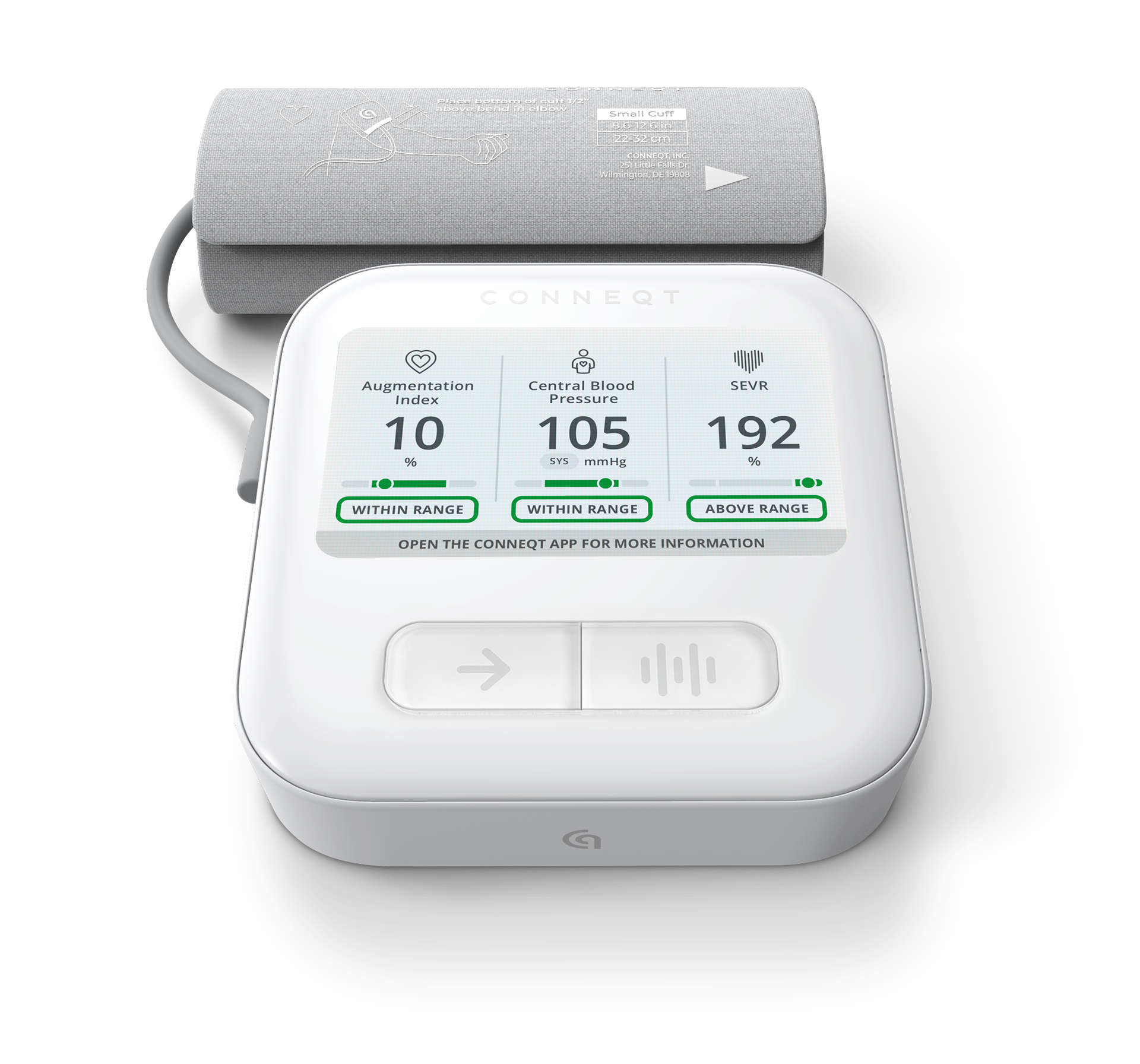A low-sodium diet, regular exercise and other heart-healthy lifestyle changes can dramatically improve blood pressure, lowering your risk of heart attack and stroke. Here are nine scientifically-proven lifestyle adjustments that could save your life.
In 2017, the American Heart Association and the American College of Cardiology released new treatment guidelines that significantly lower the criteria for high blood pressure. As a result, now almost 47% of all adults—and 80% of those over the age of 65—qualify for a hypertension diagnosis.

Measure what matters
Save 20% on checkout with code VITALITY
Known as the “silent killer” because it often presents with no symptoms, hypertension is the leading risk factor for cardiovascular disease, causing over 10 million deaths worldwide each year, according to CDC. And yet, despite the well-publicized risks associated with high blood pressure, only one in four people who suffer from high blood pressure have it under control.
The good news: If you are one of the nearly 116 million Americans who suffer from this dangerous condition, making heart-healthy lifestyle changes can dramatically reduce your risk of cardiovascular related events. Here are the top scientifically-proven ways to lower your blood pressure naturally.
1. Maintain a Healthy Weight
A 2020 review estimates 65 to 78 percent of cases of primary hypertension are related to obesity. A high percentage of fat tissue causes complex physiological changes in the body that can create or worsen hypertension. In the absence of any other changes, simply losing weight can reduce systolic blood pressure by 5 to 20mmHg.
2. Embrace a Heart-Healthy Diet
If you have hypertension, doctors routinely prescribe the Dash Diet (Dietary Approaches to Stop Hypertension). This low-sodium, high-fiber, micronutrient-rich diet emphasizes fresh, minimally processed whole foods that are low in saturated fat (think vegetables, low-sugar fruits, lean meat, and low-fat dairy products).
3. Eat Potassium-Rich Foods
In addition to cutting down on sodium, cardiologists recommend increasing your intake of potassium-rich foods like bananas. Potassium helps mitigate the negative effects of sodium in the body.
The recommended target for the average adult is 2,600 milligrams per day for women and 3,400 milligrams 4,700 mg per day, according to a new report from the National Academies of Science, Engineering, Medicine.
The more potassium you eat, the more sodium you lose via urine. This mineral also tends to ease tension in blood vessel walls, which helps further lower blood pressure.
If an individual is hypokalemic (potassium deficient) then BP will be increased, Luke Laffin, M.D., Co-Director of the Center for Blood Pressure Disorders at the Cleveland Clinic explains. He recommends increasing potassium in your regular diet rather than taking a potassium supplement.
And don’t stop at bananas! At 422 mg of potassium each, you would need to eat almost a dozen to get anywhere near your daily quota.
Instead, consider rounding out your diet with these potassium-dense staples: potatoes with skin (926 mg), yam with skin (911 mg), white beans (600 mg per half cup), carrot juice (689 mg), salmon (500 mg per three ounce filet), spinach (400 mg per half cup cooked).
One word of warning: Individuals with chronic kidney disease have to be careful not to increase potassium intake too much, Dr. Laffin says. Kidney disease can make potassium harder to eliminate in the urine and high levels of potassium in the blood increase the risk of dangerous heart rhythms, he says.
4. Exercise Regularly
Many chronic conditions, including high blood pressure, are linked to a sedentary lifestyle. Regular aerobic exercise makes your heart stronger, allowing it to pump blood more efficiently with less effort. This decreases the force of blood against arterial walls, lowering blood pressure.
Physical activity can also lead to weight loss, which, as previously noted, has a beneficial effect on blood pressure.
You don’t need to run a marathon to reap the heart-healthy benefits of regular exercise: The current guidelines from the American Heart Association recommend at least 150 minutes of moderate exercise or 75 minutes of vigorous activity a week, or a combo of the two.
The American Heart Association recommends aiming for at least 30 minutes of exercise a day, which you can break into 10-minute sessions. These are just as effective as a solid half-hour chunk of exercise.
It takes about one to three months for regular exercise to have an impact on your blood pressure and you must continue it for BP to stay low. On average, hypertensive adults can expect to see a decrease of five to seven mmHg with consistent exercise.
5. Reduce Stress
When your body experiences stress, it engages the amygdala, or fear center of the brain, Mass General cardiologist Michael Osborne, M.D., explains. After the amygdala sends a distress signal, the sympathetic nervous system releases the stress hormone cortisol which initiates a “fight or flight” response, he says. The heart rate quickens and blood vessels tighten, causing blood pressure to spike.
This is helpful if you are being chased by a bear. Less so if your email keeps pinging all day with stressful messages from work. Using advanced imaging, Dr. Osborne and his colleagues at Mass General have been able to demonstrate an association between increased metabolic activity of the amygdala (relative to regions that regulate its response) with increased markers of inflammation throughout the body, impaired metabolism, inflammation of the arteries, and risk for cardiovascular events.
“Stress reduction interventions have been shown to modify the structure of the amygdala,” Dr. Osborne says, noting that simple lifestyle adjustments such as getting more exercise, improving sleep and practicing meditation may help rewire the body’s fight or flight response to the daily stressors of modern life.
6. Avoid All Tobacco Products
Even modest smoking, defined as “above five pack years” of exposure, can raise your risk of hypertension by over 30%, according to a 2021 study in the American Journal of Hypertension.
A pack year is calculated by multiplying the number of packs of cigarettes smoked per day by the number of years an individual has smoked, according to the National Cancer Institute at the National Institutes of Health (NIH). For example, five pack years is equal to smoking five packs per day for one year, or 10 packs per day for half a year, and so on.
Nicotine stimulates the sympathetic nervous system, constricting blood vessels and making the heart beat more quickly, which causes a temporary spike in blood pressure.
Though it’s still unclear if these short surges lead to long term changes in blood pressure, high blood pressure variability—that is, daily fluctuations caused by stressors like nicotine— may be as equally as damaging as sustained high blood pressure, according to a 2016 review in the British Medical Journal.
7. Drink in Moderation (If at All)
Heavy drinking, defined as more than three drinks a day for women and four drinks for men, temporarily raises blood pressure and repeated binge drinking can lead to long term increases, according to the Mayo Clinic.
Heavy drinkers who cut back to moderate drinking (up to one drink for women and two drinks for men) can lower their systolic BP by about five-and-a-half mmHg and their diastolic by four mmHg.
While the exact mechanisms aren’t totally clear, researchers believe alcohol consumption can stimulate a hormone that constricts blood vessels and causes the body to retain water and sodium, elevating blood pressure. Hence the puffy morning after face you get after a big night of drinking.
Heavy alcohol consumption also causes your body to release cortisol, causing BP to surge as the heart rate speeds up and blood vessels narrow.
8. Improve Sleep Hygiene
When you go to bed at night, your blood pressure usually goes down. This is called “nocturnal dipping” and it’s good for your heart: It gives the organ a reprieve from the constant relentless pounding required to keep the human machine firing on all five cylinders during the day. A decrease between 10-20% is considered normal.
But people who have sleep problems often don’t experience this dip, which can increase their risk of hypertension.
Everytime you wake up in the middle of the night, your body produces cortisol, sleep specialist and spokesperson for the Sleep Foundation Raj Gasptuda, M.D., says. In addition to keeping you awake, this elevates blood pressure.
To optimize sleep, the Sleep Foundation recommends the following guidelines: commit to a regular sleep schedule that affords you at least eight hours, sleep in a completely dark and quiet bedroom, avoid stimulating blue lights two hour before bed, cut down on caffeine, and don’t eat a big meal or drink alcohol before bed.
Heavy food can cause indigestion and heartburn. And while initially sedating, alcohol tends to disrupt the deeper, more restorative cycles of sleep as the body processes the alcohol in your system, sometimes forcing you to wake up in the middle of the night to use the bathroom.
9. Monitor Your Progress
Get your blood pressure regularly checked at your doctor’s office and make sure they measure central blood pressure, too. This tells you what the pressure is near the aorta, which more accurately reflects vascular health than brachial pressure alone because it takes into account arterial stiffness (i.e. how elastic the arteries are, a key metric of heart health).
Invest in a home blood pressure monitor to track the progress of your lifestyle therapies. When measuring your blood pressure at home, do it at the same time every day, ideally in the morning. Do not smoke, drink caffeinated beverages or exercise for 30 minutes before taking the measurement. Instead, sit quietly for five minutes doing nothing. This will help ensure you get an accurate result.






